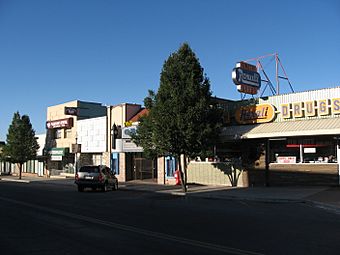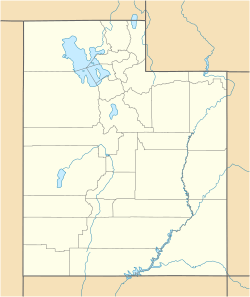Pleasant Grove Historic District facts for kids
Quick facts for kids |
|
|
Pleasant Grove Historic District
|
|

Commercial buildings in the district
|
|
| Location | Roughly bounded by 100 N., 500 S., 300 E. and 100 W., Pleasant Grove, Utah |
|---|---|
| Area | 112 acres (45 ha) |
| Built | 1853 |
| Architectural style | Late 19th and 20th Century Revivals, Late Victorian, Mid 19th Century Revival, Bungalow/craftsman |
| NRHP reference No. | 95001434 |
| Added to NRHP | December 13, 1995 |
The Pleasant Grove Historic District is a special area in Pleasant Grove, Utah, United States. It covers about 112 acres (which is like 85 football fields!). This district is important because it protects many old buildings and places that show how the town grew over time. It was added to the National Register of Historic Places in 1995, meaning it's officially recognized for its history.
Exploring the Pleasant Grove Historic District

The history of this district goes all the way back to 1853. That's when a fort was built in the area. This fort helped more people decide to settle there. At first, new buildings were mostly built inside the fort's walls. Some of these early buildings, made of adobe (a type of mud brick), are still part of the district today.
The historic district covers about 16 city blocks. It includes 134 "contributing buildings." This means these buildings are old enough and important enough to help tell the story of the district's past. They add to the area's historical value.
Different Styles of Homes
You can see many different types of houses in the Pleasant Grove Historic District. About 15 out of every 100 houses are built in the Bungalow style. These homes often have a cozy, natural look.
For example, the Vance/Lanbaugh House, built around 1915, is a great example of a Bungalow home. It was made using local rock. Bungalow houses often have special features like exposed purlins (these are horizontal beams that support the roof) and roofs that aren't very steep.
About 10 out of every 100 historic houses in the district are built in "Period Revival" styles. This means they look like they were built in an older time period, even if they were built more recently.
One example is the Clifford L. Wright House, built in 1933. It's a Tudor Revival style house. These homes often look like old English cottages. They might have a steeply sloped roof over the front door and a rounded archway for the entrance.



